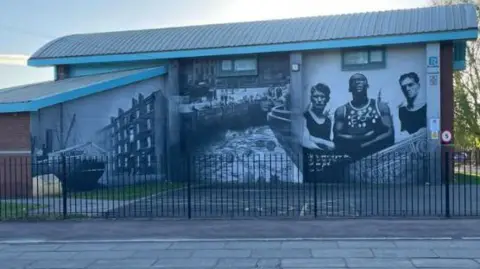'Humble' hero saved dozens of drowning children
 Courtesy of the Clarke Family
Courtesy of the Clarke FamilyCredited with saving dozens of children and adults from drowning on Merseyside in the early 20th Century, James Clarke is known as the first black man to have a street named after him in Liverpool.
A mural celebrating the "true hero" and his achievements will be officially unveiled in the city next week.
The mural, painted by renowned artist John Culshaw, will be the third in a series of works commissioned by charity Mandela8 to celebrate community role models.
Mr Clarke's family praised the "beautiful artistic tribute" which they said would ensure his heroics are celebrated for generations to come.
Who was James Clarke?
James Clarke was born in 1886 in British Guiana, now Guyana, on the northern tip of South America.
When he was 14 years old, he stowed away on a ship bound for Liverpool.
He was later adopted by an Irish family who were living on Scotland Road.
He died in 1946.
Why was he regarded as a hero?
A talented athlete, Mr Clarke worked on Liverpool's docks.
He excelled at water sports and was credited with saving dozens of children and adults from drowning in canals, docks and the River Mersey.
The Wavertree Swimming Club member also taught countless children how to swim.
He also found time to coach police boxing and swimming teams.
 Mandela8/Riverside Foundation handout
Mandela8/Riverside Foundation handoutMr Clarke was awarded several medals for swimming and for rescuing people from drowning.
Plaques dedicated to his memory have been unveiled at Eldonian Village Hall in Vauxhall and at Liverpool Aquatics Centre.
The one at Eldonian Village Hall, describing him as a "multiple life-saver", read: "Despite his fame, James was a humble and helpful person."
He was also celebrated in "Inspirational Black Scousers" tours at the Museum of Liverpool last year.
Mr Clarke's silver chain, featuring his medals, are on display in the museum's The People's Republic exhibition.
A framed certificate which he received from the Liverpool Shipwreck and Humane Society for diving into West Waterloo Dock to rescue a man from drowning on 14 February 1911 is also on show.
The museum's lead curator Kay Jones said: "James Clarke left an incredible legacy on the city that is still visible today - physically through the street named after him, but also crucially through the lives of the many people he saved from drowning and their descendants across the world.
"Teaching local children how to swim - after rescuing many of them from the Leeds and Liverpool canal - inevitably had huge positive impacts upon generations of local families."
'Beautiful tribute'
Sonia Bassey MBE, chairwoman of the Mandela8 charity which commissioned the mural in partnership with Riverside Foundation, described Mr Clarke as a "true local hero, saving many people from drowning in the Mersey and teaching so many others to swim so they could save themselves".
Mr Clarke's grandchildren, great-grandchildren, and great-great-grandchildren said they were "truly honoured and deeply grateful" for the "beautiful artistic tribute" which would ensure he is celebrated for generations to come.
They said his story was one of "strength and perseverance".
"Despite facing racism and physical abuse, he never let those struggles define him," they said.
"Instead, he rose above them to become a pillar of his community, leaving behind a legacy that continues to inspire not just our family but so many others.
"In today's world, where immigration is often spoken about negatively, his life shows the true impact of those who come here, work hard, and dedicate themselves to helping others.
"His resilience and unwavering spirit remind us all that it's not where you start but how you choose to move forward that truly matters."
Mr Clarke is said to have often told his children: "Let colour be your last excuse, not your first".
His family said that powerful message had been passed down through the generations, "reminding us that the true value lies in our actions and the choices we make".
They added: "This mural embodies that message - a powerful reminder of his selflessness and unwavering commitment to making a difference in his community."
- The mural will be officially unveiled at 13:30 BST on Wednesday at Athol Village on Leigh Bridge Way, Liverpool.
Listen to the best of BBC Radio Merseyside on Sounds and follow BBC Merseyside on Facebook, X, and Instagram and watch BBC North West Tonight on BBC iPlayer.
